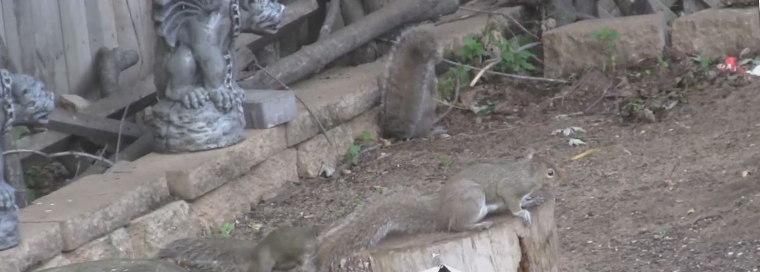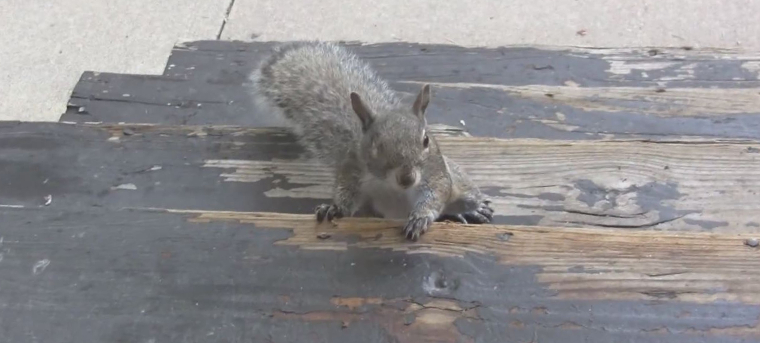-
info@aaanimalcontrol.com
Call us for help in your town
Humane Wildlife Education
The Art of Catching a Squirrel With a Snare Pole
Need squirrel removal in your hometown? We service over 500 USA locations! Click here to hire us in your town and check prices- updated for year 2020.
What is a snare pole?
A snare pole is a snare trap on a pole, just as the name would lead you to believe. A great tool used by wildlife removal controllers and rehabilitators, the snare pole enables the user to get into small, tight, and difficult-to-reach places, in which wild animals might just be hiding out.

When might a snare pole come in handy?
Squirrels aren't the only animal removal problem that could benefit from a snare pole; raccoons, opossums, skunks, and even stray or feral usually domesticated animals are all easily captured when a snare pole is used by a trained professional.
Squirrels and other animals that have become defiantly or otherwise trapped in chimneys are easily grabbed and removed using a snare pole, as are other animals. The same approach can also be taken to remove wild critters, including squirrels, that have gotten stuck in wall cavities, crawl spaces, and more.
Where can you buy a snare pole?
We do not recommend using a snare pole if this is your first time — there are a number of things that have the potential to go wrong, including injury or death to the animal in question.
You can buy snare poles online and in some hardware stores, but you will usually find that local wildlife rehabilitators and control officers will have them to hand. Although there is a pretty good chance they won't lend you the item, they can come along and assist in removing the squirrel. Chances are the job is cheaper than you'd think too.
The only way you'll find out is by calling up and getting a quote.
Can you make a snare pole?
Just as with using a snare pole, we do not recommend that you attempt to make a snare pole unless you know how to do so safely, and in such a way that you can ensure the relative comfort and safety of the animal.
Snare poles are get too tight can tear into flesh, strangle, and worse. A handmade design can also easily break. If you injure the animal and the snare pole breaks, there is a chance that part of the pole will scamper off with the animal, never to be seen again. Sadly, a snared animal won't last long when it has escaped back out into the wild.
How to catch a squirrel with a snare pole?
You will need to understand and appreciate the surroundings of the squirrel before using a snare pole, and you will also need to know the size and weight of the animal you're targeting. This information will help with the snare size itself, as well as other things.
You will also need to understand and appreciate the behavior of squirrels to know where they are likely to scamper off when you get close. Even the most expert of rehabilitators can miss a few times. If this is your first time, the job is likely to be a frustrating one.
A trap or cage is essential to move the animal into once you have trapped it using your snare pole, and you will also want to make sure you have a blanket or something to cover it up, thick gloves to protect yourself, and some eye protection and a breathing mask … just in case there are any disease risks lurking around. (There probably will be.)
Once you have safely trapped the squirrel, you can't release it yet. You will need to make sure that you are dealing with just the one animal and not a mother with young in tow, and you will also need to make sure that you are sealing up the holes that the animals were using to gain entrance. You should watch the animals for a while, and do some investigative work. You'll soon start to see signs — feces and urine, for example— and these will lead you to the areas of high activity. This is where you should be focusing your attentions, particularly if you want to find the nest.
How to Use a Snare Pole to Catch a Squirrel
Need squirrel removal in your hometown? We service over 500 USA locations! Click here to hire us in your town and check prices- updated for year 2020.
Snare poles come in handy when you find yourself with a wild animal in a spot where you just can't reach it. Any poling and prodding with a stick will just encourage the creature to find somewhere deeper and darker to hide, and that won't suit anyone at all. You need something that will poke and grab at the same time, and that's where the snare pole comes into play; although, we don't recommend using one if you're not quite sure how to.

Snare poles are known by other names; another common one is catch pole (or catchpole). They all do pretty much the same thing — a long pole with a snare trap at the end, designed to reach animals that you can't reach normally, and snare them. Some are designed to kill; others are designed to simply grab or trap, allowing you to then safely deposit that animal into a container or cage trap. If you have more than one squirrel, it is wise not to try and put them into the same container or trap. One will escape while you try to add another. It could end up being an almost-hilarious squirrel-cycle.
If you were thinking of using a snare pole, sadly, many states across America require users to carry appropriate permits or licenses. It's not the kind of thing that you can just grab from a local hardware store and throw around in the attic, hoping for the best. Incorrect use of snare poles can lead to injured or dead animals, and this could even land you in hot water too. It is actually illegal to kill squirrels in many states.
If you don't have a snare pole, you could try your hand with a net, although, you may find that the animal does a much better job of scampering off than you do of actually cornering it.
For more information, you may want to click on one of these guides that I wrote:
How much does squirrel removal cost? - get the lowdown on prices.
How to get rid of squirrels - my main squirrel removal info guide.
Example squirrel trapping photographs - get do-it-yourself ideas.
Squirrel job blog - learn from great examples of squirrel jobs I've done.
Squirrels in the attic - what to do to solve the problem.


















